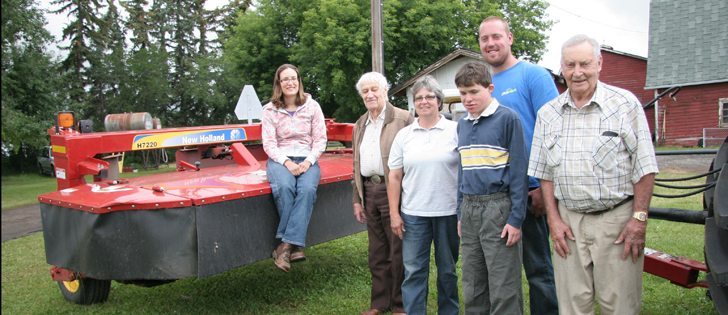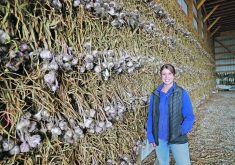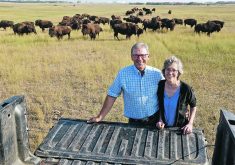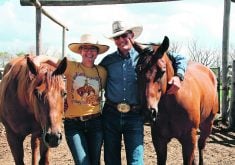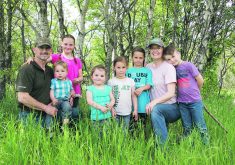SPRINGBANK, Alta. — Rocky View Farm has captivated four generations of Longeways.
Located west of Calgary in the district of Springbank, the farm oversees purple mountains, blue skies and yellow rays of sunlight across the foothills.
“It doesn’t matter what time of the day or day of the week, you look out on the mountains and there is always something different,” said Debbie Lee.
“The way the light shines in the morning, you see something, and by the time the shadows come in the late afternoon, you can look at the same thing and realize it changed.”
Read Also

Sustainable food has ‘lost all meaning’: prof
That marketing strategy is deader than a doornail, says a University of Guelph professor who specializes in consumer preferences and perceptions of agriculture and food.
The family has farmed in the area for 100 years with a strong commitment to agriculture and community.
Lee works with her 86-year-old father, Eric Longeway, daughter Danielle, son Jeff and assorted other relatives.
Recently named master farm family by Rocky View County, the Longeway family established the farm in 1912 after Eric’s father, Howard Longeway, came for a visit.
He liked the area so much that he left his job managing a ranch in Montana and bought the quarter section next to his brother, who had arrived in 1910. Howard named it Rocky View Farm.
The family traces its roots to Quebec’s Eastern Townships and before that to Protestant Huguenots who fled religious persecution in France.
They eventually found their way to Canada and the United States in the late 17th century. A branch of the Longeway family still farms in Quebec.
Located between the Bow and Elbow rivers, the farm has been favoured with a good climate and fertile soil.
“We have been farming here for 100 years and we have never had a complete crop failure yet by hail or anything,” Eric Longeway said.
The farm has raised mink, bees, pigs, poultry, crops and hay as well as beef and dairy cattle. Throughout most of his farming career, Longeway worked with his brother, Gerald, who is now 90.
The mainstay of the farm was a dairy, in which they milked 60 registered Jerseys. Springbank was once the heart of Alberta’s dairy industry, but over time farms folded and now the area is a patchwork of grand country homes amidst cropland and pastures.
“Everything worked good,but Jerseys were our main thing and milk was what kept us going all the time,” he said.
Holstein cows were milked by hand until 1918, when the family added a milking machine because farm labour was hard to find with so many young men fighting in the First World War.
The Jerseys were babied and milked by hand until 1935 and then a modern milking system was in-stalled.
The Longeways sold pedigreed cattle around the world and had the first herd in Canada to receive a constructive breeder award from Jersey Canada, which recognizes excellence in Jersey breeding for milk production and conformation.
Eric was president of Jersey Canada and of a milk foundation that provided milk to the needy. He also helped found the Dairy Nutrition Council of Alberta to promote milk products.
These days, his granddaughter, Danielle Lee, does contract work with Alberta Milk as well as keeps up her duties on the farm.
The family phased out the dairy in 1994 because of the workload and the expense of upgrading to meet government regulations. They also didn’t have the land base to expand.
“This whole thing made it on a quarter section and a quarter section rented,” Longeway said.
“Now can you make a living on a quarter section of land? No. In those days you could.”
The family lives in a community where developers hungrily eye every quarter section as another windfall. They have been approached to sell many times, but Longeway refuses.
“It gets in your blood and you stay here,” he said. “Farming around here isn’t what you call really economical. When you look at it, you can’t afford to farm here, but you do it out of sentimental reasons, that’s about all.”
He was a member of the municipal agriculture service board and learned that 10,000 acres in his area are in the hands of developers.
“It will never go back to agriculture,” he said.
Land sales are more likely to be made to developers rather than a new farmer. Local farms tend to be passed on because no one can compete for labour or land.
Today, the family maintains a small cow-calf herd, sheep and other livestock, but the main business is making and selling top quality hay, mostly for the local horse market.
They put up more than 30,000 small, square bales of mixed grass hay last year that receives no pesticides. However, they do fertilize.
They are conscious of their neigh-bours as they carry on their day to day farm work. Some complain about the noise and dust while others are delighted to see cows grazing next door.
That kind of environment makes it hard for young people to consider agriculture. Calgary continues to sprawl west toward their property with the lure of better paying and cleaner jobs.
The choice to work on the farm was not difficult for Danielle and her cousin, Eric Longeway. Eric works for Dairyland Milk in Calgary, but spends as much time as possible on the farm. Danielle returned after completing her degree in agriculture at the University of Alberta, her grandfather’s alma mater in 1948.
“I’m here because I love agriculture and I have grown up here so the farm is my second home,” she said.
“I think there is lots of opportunity in agriculture. Sometimes you have to change things to find it, but we always need food.”
Eric grew up in the city but likes the outdoors and learning about food production.
“It is definitely a learning experience and I find it interesting,” he said.
Debbie Lee’s oldest brother, Howard, also farmed but recently retired because of health problems. The other brothers, Jim and Ken, work in Calgary. They all come back and help evenings and weekends or pitch in for family work bees to do repairs, work in the garden or put up hay.
“They come out when they are able to,” said Lee, whose husband, Pat, works in the city, while she commutes to the farm each day.
Volunteering also keeps the family together.
Longeway always believed in giving back to his community, and that attitude continued for his children and grandchildren. He has received the senior service award for his commitment to seniors in the province, and has volunteered with the Stampede dairy committee. He was also an active showman.
Lee became the first female chair of the dairy committee and was a founder of Aggie Days, a five day children’s agriculture fair. To continue the education thread, Danielle recently became a committee chair of Agtivity in the City, which is held during the Stampede as a dedicated agriculture education site on the grounds.
Aggie Days is a tour de force, in which the entire family has participated. It started as a few demonstrations during the Stampede Dairy Classic show held each spring.
In 27 years, it has grown into an agriculture extravaganza taking up 100,000 sq. feet in two exhibition halls as well as a theatre and arena.
Three days are set aside for school groups, including a morning for special needs children. The doors are opened on the weekend to 30,000 children and their parents.
The organizers invited commodity groups and agribusinesses, stipulating that they must educate and cannot sell anything. They want people to learn the truth about food production and believe reaching children may be the best way to spread the word.
The demographics of the show is changing with more new Canadians visiting each year.
“For them to come and see how we raise things is quite an eye opener for them,” said Danielle.
Visitors are encouraged to ask questions.
“It is when people don’t give their kids the right information or the kids see something and are afraid to ask and then assume the wrong thing,” Lee said. “We have young people who have never been on a farm and they are raising young kids.”
Danielle said people are more connected with social media and have seen good and bad information on food production.
“Each year you find people are further removed, but I find each year people are asking more questions,” she said.
Aggie Days is also a family affair for the exhibitors and volunteers. Vacations are organized so that they have time to put on the show and make it better every year.
Longeway appreciates the effort because when he showed cattle he always made time for the public by explaining what he was doing and emphasizing the importance of dairy’s contribution to food production.
“We do love to share our agriculture knowledge with other people,” said Lee, speaking for her entire family.
“We are proud of what we do.”




